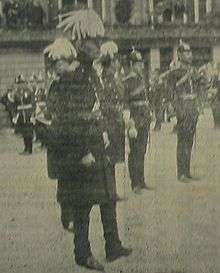Alexander Rochfort
Major-General Sir Alexander Nelson Rochfort KCB CMG (3 June 1850 – 5 December 1916) was a British Army officer who became Lieutenant Governor of Jersey.
Sir Alexander Rochfort | |
|---|---|
 | |
| Birth name | Alexander Nelson Rochfort |
| Born | 3 June 1850 Clogrennane, County Carlow, Ireland |
| Died | 5 December 1916 (aged 66)[1] Piccadilly, London |
| Allegiance | |
| Service/ | |
| Years of service | 1871–1916 |
| Rank | Major-General |
| Battles/wars | Second Boer War World War I |
| Awards | Knight Commander of the Order of the Bath Companion of the Order of St Michael and St George |
Rochfort was born in County Carlow, Ireland, the fifth son of Horace William Noel Rochfort and Hon. Charlotte Hood, daughter of Samuel Hood, 2nd Baron Bridport.[1][2]
Military career
Rochfort was commissioned into the Royal Artillery in 1871.[3] He was appointed Aide de camp to the Viceroy of India in 1882 and then Aide de camp to the Chief of Staff of the Expeditionary Force to Suakin in 1885 before taking part in the Second Boer War which broke out in South Africa in October 1899.[3] He was present at the Relief of Kimberley and at the Battle of Paardeberg,[4] was mentioned in despatches (31 March 1900[5]) was severely wounded,[4] and appointed a Companion of the Order of the Bath (CB). During the latter part of the war, he was in command of a column operating in the north-west of Orange River Colony.[6] In despatches dated 23 June 1902, Lord Kitchener, Commander-in-Chief in South Africa, described Rochfort as "fearless of responsibility, never makes difficulties, and has ... all the qualifications for a leader in the field."[7] Following the end of the war with the Peace of Vereeniging on 31 May 1902, he returned home on the SS Saxon which arrived at Southampton in late October 1902.[8]
He went back to Africa to be a Special Service Officer in the Somaliland Field Force in 1902, returning to become Inspector of the Royal Horse Artillery and Royal Field Artillery in 1904. He was appointed Lieutenant Governor of Jersey in 1910, serving as such until he retired in October 1916.[3] He was found dead at his chambers in Piccadilly in December 1916.[4]
References
- Burke, Sir Bernard, ed. (1914). Burke's Peerage, Baronetage & Knighthood (76th ed.). Burke's Peerage & Gentry. p. 2502.
- "Obituary: General Sir A. N. Rochfort". The Times. The Times Digital Archive. 6 December 1916. p. 12.
- Sir Alexander Rochfort Liddell Hart Centre for Military Archives
- Channel Island Great War Study Group
- "No. 27282". The London Gazette. 8 February 1901. p. 846.
- "The War - Lord Kitchener´s report". The Times (36754). London. 29 April 1902. p. 5.
- "No. 27459". The London Gazette. 29 July 1902. pp. 4835–4837.
- "The Army in South Africa - Troops returning Home". The Times (36892). London. 7 October 1902. p. 8.
| Government offices | ||
|---|---|---|
| Preceded by Hugh Gough |
Lieutenant Governor of Jersey 1910–1916 |
Succeeded by Sir Alexander Wilson |